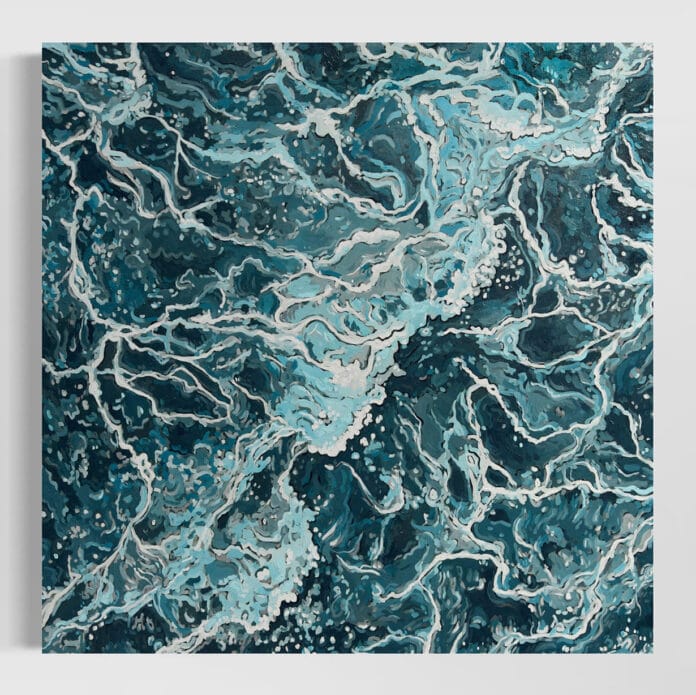In Tides (2024), American artist and illustrator Chris Arnold invites viewers to step into the ever-changing dance of nature. Rendered in acrylic on canvas, the painting is a contemplative visual poem centered on the metaphor of water, specifically the rhythmic motion of ocean tides, as a symbol for the flux of life. The work speaks to themes of movement, stillness, abundance, scarcity, and the enduring resilience required to navigate change.
Exploring Tides: Nature as Metaphor
Water has long held symbolic meaning across cultures, cleansing, life-giving, and unpredictable. In Tides, Arnold transforms the physical rhythm of the ocean into a conceptual exploration of the human experience. The rise and fall of waves echo the emotional and circumstantial cycles we encounter: joy and sorrow, growth and retreat, connection and solitude.
Arnold’s use of acrylics lends the piece a sense of immediacy and texture. The fluidity of the medium mirrors the liquidity of the subject matter, with layers that suggest movement beneath the surface. The painting does not merely depict the sea; it channels it, asking the viewer not to observe, but to feel.
The Balance Between Movement and Stillness
One of the most compelling aspects of Tides is its invitation to reflect on personal rhythm. We often move through life at a relentless pace, caught between external demands and internal desires. In this work, Arnold reminds us of the quiet wisdom found in natural patterns: tides move with purpose but also with rest. There is no shame in stillness, no failure in ebbing. Like the ocean, we are allowed to pull back, to reflect, to gather strength before surging forward once more.
This theme resonates deeply in an era marked by overstimulation and burnout. Tides become a call to realign with the natural tempo of life, encouraging resilience through balance.
Artistic Influences and Visual Language
Arnold’s visual style is distinct and multifaceted, shaped by a wide range of influences from the expressive brushwork of Impressionism and the organic curves of Art Nouveau to the clarity and storytelling of comic art. In Tides, these elements converge harmoniously.
Bold yet fluid forms give the piece its initial impact, while the details swirling currents, hidden marine shapes, and layered tonal variations draw the viewer into a more introspective space. His illustrative background enables him to communicate complex ideas with accessible imagery, a signature quality found throughout his body of work.
Color plays a vital role here. The palette transitions from deep indigos to soft aquas, reflecting both the literal and emotional tides within the viewer. There’s a sense of immersion, as if standing at the shoreline and watching one’s thoughts carried in and out with the waves.
About the Artist: Chris Arnold
Chris Arnold is a U.S.-based artist and illustrator whose practice is rooted in the interconnectedness of the natural world. Born with a deep respect for the environment, his work often addresses themes of conservation, ecology, and sustainability, sometimes directly, often metaphorically.
Arnold holds an MFA in Illustration from the Savannah College of Art and Design (SCAD) and a BFA from the University of Missouri. Over the years, his work has been commissioned by organizations like the Ron Finley Project, House Beautiful, and the U.S. National Park Service. His art has appeared in exhibitions across the country and is held in both private and corporate collections worldwide.
Whether painting in the studio or sketching in the garden, Arnold’s process is immersive and intuitive. He is driven by a desire to make art that is not only visually engaging but also mentally and emotionally impactful. His illustrations and paintings often blur the lines between fine art and narrative illustration, creating visual stories that stir both curiosity and reflection.
Environmental Reflection Through Art
Arnold’s body of work frequently underscores our relationship with the environment, not just as stewards, but as part of a delicate and responsive ecosystem. Tides continues this tradition, serving as both a meditation and a quiet call to action. It reminds us that our own well-being is tied to the health of the natural world and that paying attention to its rhythms can teach us how to better care for ourselves and our surroundings.
The painting also emphasizes resilience, not the aggressive kind, but the quiet, enduring strength found in nature’s patterns. In a world facing environmental crises and societal uncertainty, Tides offers a moment of pause. It encourages us to realign not just with nature, but with ourselves.
Conclusion: A Visual and Emotional Compass
Tides is more than a painting; it is a visual compass guiding viewers toward presence, reflection, and restoration. Chris Arnold has crafted a piece that transcends decorative appeal, positioning itself instead as a contemplative artifact, one that asks not what we see, but how we feel, how we move, and how we adapt.
By blending aesthetic sophistication with environmental consciousness and emotional depth, Arnold continues to assert his role as an artist deeply in tune with the pulse of the planet. Tides is both timely and timeless, an artwork that mirrors the oceans we stand before and the emotional tides we carry within.


